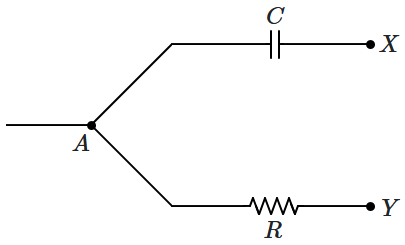In which of the following circuits can the power factor be zero?
1. LC circuit
2. LCR circuit
3. Purely resistive circuit
4. Both (1) & (2)
| Assertion (A): | A capacitor can replace the choke coils in an AC circuit. |
| Reason (R): | A capacitor can reduce the current in an AC circuit like an inductor |
In the light of the above statements choose the correct answer from the options given below:
| 1. | Both (A) and (R) are true and (R) is the correct explanation of (A). |
| 2. | Both (A) and (R) are true but (R) is not the correct explanation of (A). |
| 3. | (A) is true but (R) is false. |
| 4. | Both (A) and (R) are false. |
Given below are two statements: one is labelled as Assertion (A) and the other is labelled as Reason (R):
| Assertion (A): | On the increasing frequency of a.c. through a conductor resistance of the circuit may increase. |
| Reason (R): | Resistance of a conductor is directly proportional to the frequency of the a.c. input. |
In the light of the above statements choose the correct answer from the options given below:
| 1. | Both (A) and (R) are true and (R) is the correct explanation of (A). |
| 2. | Both (A) and (R) are true but (R) is not the correct explanation of (A). |
| 3. | (A) is true but (R) is false. |
| 4. | Both (A) and (R) are false. |
What is the value of the power factor for a parallel LC circuit at a frequency less than the resonance frequency?
1. Zero
2. 1
3. > 1
4.< 1
| 1. | about \(14~\text{A}\) | 2. | about \(28~\text{A}\) |
| 3. | about \(20~\text{A}\) | 4. | cannot say |
An alternating current generator has an internal resistance \(R_{g}\) and an internal reactance \(X_{g}\). It is used to supply power to a passive load consisting of a resistance \(R_{g}\) and a reactance \(X_{L}\). For maximum power to be delivered from the generator to the load, the value of \(X_{L}\) is equal to:
1. zero
2. \(X_g\)
3. \(-X_g\)
4. \(R_g\)
| (a) | the maximum voltage between plates is \(220\) V. |
| (b) | the current is in phase with the applied voltage. |
| (c) | the charge on the plates is in phase with the applied voltage. |
| (d) | power delivered to the capacitor is zero. |
| 1. | (b), (c) | 2. | (a), (d) |
| 3. | (b), (d) | 4. | (c), (d) |
| (a) | zero average current |
| (b) | \(220~\text V\) average voltage |
| (c) | voltage and current out of phase by \(90^\circ\) |
| (d) | voltage and current possibly differing in phase \(\phi\) such that \(|\phi|<\dfrac \pi 2.\) |
Choose the correct options:
1. (b), (c)
2. (a), (d)
3. (b), (d)
4. (a), (c)
A resistor of \(40~\Omega\) is connected to the secondary of a step-down transformer, with an input voltage of \(200~\text V\) and an output of \(20~\text V\) across the secondary.
The resistance as seen in the primary circuit is: (ignoring power losses)
1. \(40~\Omega\)
2. \(4~\Omega\)
3. \(0.4~\Omega\)
4. \(4~\text k\Omega\)

| 1. | zero | 2. | \(\sqrt 2 V_r \) |
| 3. | \(2 V_r\) | 4. | \(\dfrac{V_r}{\sqrt 2}\) |




